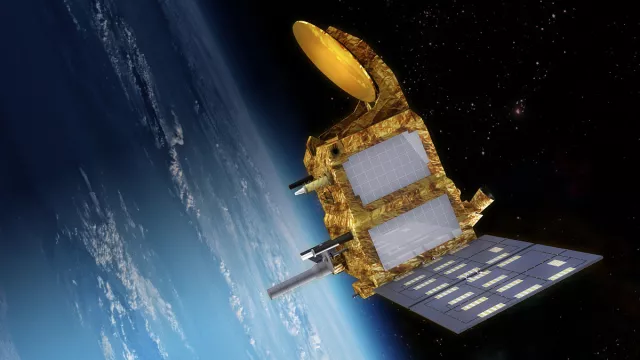SARAL/AltiKa is the world’s first satellite equipped with a Ka-band (35.75 GHz) altimeter for measuring ocean sea-surface height.
Key information
Key figures
- 4 instruments
- 400 kg: satellite mass
- 8 mm: altitude measuring precision of AltiKa instrument
- 2 km: spatial resolution of AltiKa instrument
Key milestones
- 25 February 2013: SARAL launched by PSLV
- 11 July 2012: Payload module shipped to India
- 1 June 2010: Environmental testing starts on payload module
- 2 March 2007: CNES/ISRO agreement to build SARAL satellite
Project in brief
Launched on 25 February 2013, the SARAL/AltiKa satellite is a joint French-Indian project focusing on environmental observation and monitoring. The satellite bus, which was developed by the Indian space agency, carries two independent instruments—Argos-3 and AltiKa. Argos-3 is the third-generation receiver of the Argos system, able to locate and collect environmental data from any ‘platform’ equipped with an Argos transmitter, from drifting buoys to turtles or birds.
AltiKa is a ground-breaking payload that incorporates an altimeter, radiometer and DORIS positioning instrument. It measures ocean surface topography using a very high electromagnetic wave frequency—the Ka band (around 35.75 GHz instead of the previous 13.6 GHz). Developed for CNES by Thales Alenia Space, the AltiKa altimeter provides improved ground resolution, giving a clearer picture of coastlines, rivers and lakes. It also penetrates less deeply into snow and ice, thereby yielding information about their surface levels. So, in addition to contributing to mesoscale (50 to 500 kilometres) ocean current observations that are essential to our understanding of ocean dynamics and their impact on climate, AltiKa data are also widely used by glaciologists and hydrologists.
Placed in the same 800-kilometre polar orbit as the former Envisat satellite, SARAL/AltiKa is able to acquire long time-series of data required for studying climate change. AltiKa data are also used in operational oceanography and on a daily basis by the Copernicus Marine Environment and Monitoring Service (CMEMS) and by the French and European national weather services.
CNES’s role
The payload developed by CNES comprises:
- An AltiKa altimeter-radiometer (CNES)
- A DORIS precise orbit determination system (CNES)
- A Laser Retroreflector Array (LRA) for precisely calibrating the instruments by analysing laser beams fired from Earth and reflected on board the satellite by a set of mirrors (CNES
- An Argos-3 instrument
The AltiKa altimeter was developed for CNES by Thales Alenia Space. CNES receives and exploits data through its SALP altimetry and precise positioning department.
Contacts
Project Leader
Thierry Guinle
E-mail: thierry.guinle at cnes.fr
Oceans subject matter expert
Yannice Faugère
E-mail: yannice.faugere at cnes.fr


